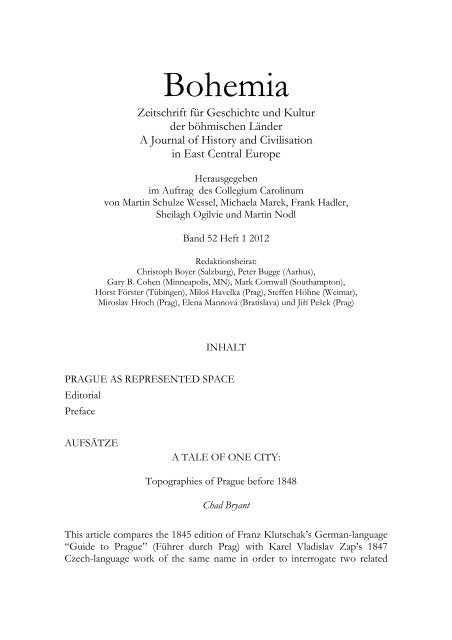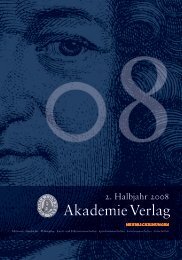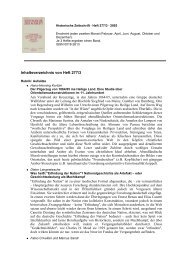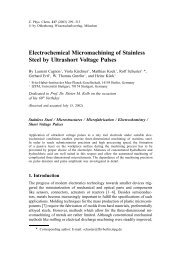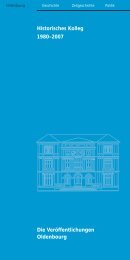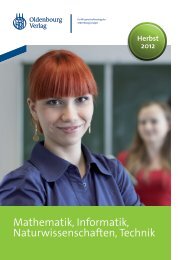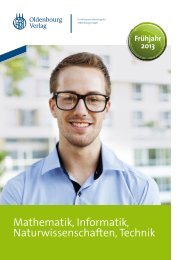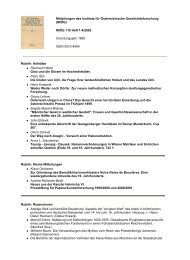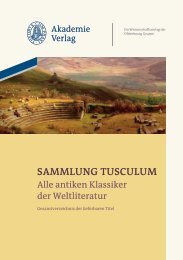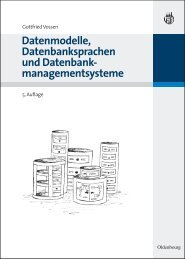Bohemia - Oldenbourg Verlag
Bohemia - Oldenbourg Verlag
Bohemia - Oldenbourg Verlag
You also want an ePaper? Increase the reach of your titles
YUMPU automatically turns print PDFs into web optimized ePapers that Google loves.
<strong>Bohemia</strong><br />
Zeitschrift für Geschichte und Kultur<br />
der böhmischen Länder<br />
A Journal of History and Civilisation<br />
in East Central Europe<br />
Herausgegeben<br />
im Auftrag des Collegium Carolinum<br />
von Martin Schulze Wessel, Michaela Marek, Frank Hadler,<br />
Sheilagh Ogilvie und Martin Nodl<br />
Band 52 Heft 1 2012<br />
Redaktionsbeirat:<br />
Christoph Boyer (Salzburg), Peter Bugge (Aarhus),<br />
Gary B. Cohen (Minneapolis, MN), Mark Cornwall (Southampton),<br />
Horst Förster (Tübingen), Miloš Havelka (Prag), Steffen Höhne (Weimar),<br />
Miroslav Hroch (Prag), Elena Mannová (Bratislava) und Jiří Pešek (Prag)<br />
INHALT<br />
PRAGUE AS REPRESENTED SPACE<br />
Editorial<br />
Preface<br />
AUFSÄTZE<br />
A TALE OF ONE CITY:<br />
Topographies of Prague before 1848<br />
Chad Bryant<br />
This article compares the 1845 edition of Franz Klutschak’s German-language<br />
“Guide to Prague” (Führer durch Prag) with Karel Vladislav Zap’s 1847<br />
Czech-language work of the same name in order to interrogate two related
sets of questions concerning the history of Vormärz Prague. First, the two<br />
works tell much about the changing form, content, and popularity of<br />
topographies, a scholarly genre that provided readers with information about<br />
the city’s climate, population, history, and, most important, physical<br />
structures. Klutschak and Zap’s works demonstrate how authors working<br />
within this genre adapted their topographies to appeal to early nineteenthcentury<br />
travelers and a growing number of local, bourgeois elites interested in<br />
their city and its structures. Second, Klutschak and Zap’s topographies reveal<br />
much about how the two men thought about the past and the present, which<br />
in turn points to numerous ways in which Prague’s elites, whether Czech- or<br />
German-speaking, shared a common cultural and mental universe. In this<br />
discourse they represent two sides of an ongoing debate about the wrenching<br />
changes experienced in the years before 1848.<br />
L’HISTOIRE D’UNE VILLE:<br />
Les topographies de Prague de la période devant 1848<br />
Chad Bryant<br />
Cet article compare l’édition de 1854 du „Guide de Prague“ (Führer durch<br />
Prag) en allemand de Franz Klutschak avec celle du guide en tchèque du<br />
même nom de Karel Vladislav Zap paru en 1847 dans le but de débattre sur<br />
deux séries de questions liées à l’histoire de Prague durant le Vormärz. En<br />
premier lieu, les deux ouvrages révèlent beaucoup sur la forme changeante, le<br />
contenu et la popularité des topographies, un genre savant qui fournissait aux<br />
lecteurs des informations sur le climat d’une ville, sa population, son histoire<br />
et surtout sur ses structures matérielles. Les ouvrages de Klutschak et Zap<br />
montrent comment les auteurs travaillant sur ce genre adaptaient les<br />
topographies pour attirer les voyageurs et le nombre grandissant des élites<br />
bourgeoises locales qui étaient intéressées par leur ville et ses structures. En<br />
deuxième lieu, les topographies de Klutschak et Zap dévoilent comment les<br />
deux hommes voyaient le passé et le présent, ce qui à son tour nous montre<br />
comment les élites de Prague – indépendamment du fait qu´elles parlaient<br />
allemand ou tchèque – partageaient à de nombreux points de vue un univers<br />
culturel et spirituel commun. Dans ce discours, ils représentent les deux côtés<br />
d´un débat récurrent sur les changements profonds des années précédant<br />
1848.
DĚJINY JEDNOHO MĚSTA:<br />
Topografie Prahy z doby před rokem 1848<br />
Chad Bryant<br />
Příspěvek srovnává německy psané vydání „Průvodce po Praze“ (Führer<br />
durch Prag) od Franze Klutschaka z roku 1845 se stejnojmennou česky<br />
psanou prací Karla Vladislava Zapa z roku 1847 a to s cílem analyzovat dva<br />
spolu spojené komplexy otázek k dějinám Prahy předbřeznové doby. Obě<br />
práce zaprvé vypovídají mnoho o měnící se formě, obsahu a popularitě<br />
topografií, učeném žánru zásobujícím čtenáře informacemi o podnebí města,<br />
obyvatelstvu, dějinách a především o jeho fyzické struktuře. Klutschakovo a<br />
Zapovo dílo ukazuje, jak autoři pracující s tímto žánrem své topografie<br />
upravovali, aby oslovili cestovatele a rostoucí počet domácích měšťanských<br />
elit se zájmem o město a jeho strukturu. Zadruhé obě topografie prozrazují,<br />
jak oba muži uvažovali o minulosti a přítomnosti, z čehož je dále patrné, že<br />
pražské elity – bez ohledu na to, zda mluvily česky či německy – v mnoha<br />
ohledech sdílely společný kulturní a duchovní svět. V tomto diskurzu<br />
představují dvě strany probíhající debaty o dalekosáhlých změnách, ke kterým<br />
došlo v době před rokem 1848.<br />
CONSTRUCTING SLAVIC PRAGUE:<br />
The “Grünberg Manuscript” And Public Space in discourse<br />
Marek Nekula<br />
This article focuses on the nineteenth century and contemporary narratives of<br />
Prague as well as the transformation of the city’s public space. The author<br />
proceeds on the assumption that the “Grünberg Manuscript”, as a central text<br />
in Czech culture, sketched a mental map of <strong>Bohemia</strong>n-Slavic space whose<br />
center was represented by Vyšehrad and an image of Prague closely identified<br />
with Vyšehrad. This mental map was also the context for the staging and<br />
media representation of Václav Hanka’s funeral. In this way the meaning of
Prague became associated with Vyšehrad, marking an important step in the<br />
iconographic transformation of Prague’s public space. The funerals of Hanka<br />
and Božena Němcová led namely to the foundation of the “Svatobor”<br />
association, which initiated the transformation Prague’s public space, hitherto<br />
characterized by a nationally ambivalent iconography, into a <strong>Bohemia</strong>n-Slavic<br />
space. This transformation manifested itself in the monuments to Hanka<br />
(1863) and Josef Jungmann (1878, foundation stone laid in 1873) erected<br />
using the association’s funds.<br />
In terms of methodology, this article is based on cultural semiotics,<br />
connecting it to other recent studies of the public sphere. With reference to<br />
New Historicism the article relativizes the distinction between “high cultural”<br />
and “trivial” texts, showing how a “cultural text” also determined<br />
contemporary commemorative practices.<br />
CONSTRUIRE LA PRAGUE SLAVE:<br />
Le „manuscript de zelená hora“ (ou Grünberg) et le discours public<br />
Marek Nekula<br />
Cet article se concentre sur le XIX e siècle et sur les récits contemporains de<br />
Prague ainsi que sur la transformation de l’espace public de la ville. L’auteur<br />
part de l’hypothèse que le „Manuscript de Zelená Hora“ (ou de Grünberg), en<br />
tant que texte central dans la culture tchèque, esquissait une ébauche d’une<br />
carte mentale de l’espace slavo-tchèque dont le centre était représenté par<br />
Vyšehrad et par la Prague associée à Vyšehrad. Cette carte mentale fut aussi<br />
l’arrière-plan pour la mise en scène et la représentation médiale des funérailles<br />
de Václav Hanka. De cette manière, Prague fut ainsi liée dans sa signification à<br />
Vyšehrad, ce qui marqua une étape importante sur la voie de la transformation<br />
iconographique de l’espace public pragois. Les funérailles de Hanka et Božena<br />
Němcová furent à vrai dire à l’origine de la fondation de l’association<br />
„Svatobor“, qui lança l’idée de la transformation de l’espace public pragois,<br />
caractérisé jusque-là par son iconographie nationale ambiguë, en un espace<br />
dédié à la culture slavo-tchèque. Cette transformation fut concrétisée avec la<br />
création des monuments funéraires individuels de Hanka (1863) et de Josef
Jungmann (1878, pierre de fondation posée en 1873) qui furent financés avec<br />
les fonds de l’association.<br />
En termes de méthodologie, cet article est basé sur la sémiotique<br />
culturelle, qui est reliée à d’autres études récentes de la sphère publique. En<br />
référence au „New Historicism“, cet article relativise la distinction entre textes<br />
„hautement culturels“ et „triviaux“, en montrant comment un „texte culturel“<br />
détermine aussi les pratiques commémoratives contemporaines.<br />
KONSTRUKCE SLOVANSKÉ PRAHY:<br />
„Zelenohorský rukopis“ a veřejný diskurz<br />
Marek Nekula<br />
Článek se soustředí na 19. století a dobové narativy Prahy stejně jako na<br />
transformaci veřejného prostoru města. Autor vychází z toho, že<br />
„Zelenohorský rukopis“ jako klíčový text české kultury načrtl mentální mapu<br />
českoslovanského prostoru, jejíž jádro představoval Vyšehrad a k němu<br />
vztažená Praha. Tato mentální mapa je podle autora také v pozadí inscenace i<br />
mediální reprezentace pohřbu Václava Hanky. Jím se Praha významově<br />
napojila na Vyšehrad, což byl důležitý krok na cestě k ikonografické proměně<br />
pražského veřejného prostoru. Pohřeb Václava Hanky a Boženy Němcové<br />
totiž vedl k založení spolku „Svatobor“, který spustil transformaci pražského<br />
veřejného prostoru, ikonograficky dosud národně ambivalentního, v prostor<br />
českoslovanský. Tato přeměna se manifestuje v pomnících Hankovi (1863) a<br />
Josefu Jungmannovi (1878, základní kámen 1873), které byly postaveny na<br />
náklady spolku.<br />
Metodologicky se příspěvek hlásí ke kulturní semiotice, kterou napojuje<br />
na novější studie k veřejnosti. S odvoláním na nový historismus článek<br />
relativizuje rozlišení tzv. vysokých a nízkých textů a ukazuje, jak „text kultury“<br />
určuje i praktiky dobových vzpomínkových akcí.
CELEBRATING SLAVIC PRAGUE:<br />
Festivals and the Urban Environment, 1891-1912<br />
Claire E. Nolte<br />
In the course of the nineteenth century, Prague was transformed from a<br />
provincial German city into a modern Czech metropolis. As the population of<br />
the city grew, an influx of Czech-speaking peasants changed its ethnic<br />
makeup. In 1861, the first Czech mayor of the city was elected, beginning an<br />
era of Czech domination of city government that lasted until the end of the<br />
monarchy. The Czech mayors of Prague undertook to remake their city into a<br />
modern metropolis with a distinctly Czech character. In addition to<br />
modernization projects like ghetto clearance, these leaders imprinted a Czech<br />
identity on the public space with new representational buildings and other<br />
projects. In the years leading up to World War I, the city hosted grand<br />
festivals that attracted international attention and enhanced its reputation as a<br />
modern urban center. Three events exemplify this process: the 1891 Jubilee<br />
Exhibition, the first great triumph for Czech Prague; the 1895 Ethnographic<br />
Exhibition, a celebration of national identity; and the 1912 gymnastic festival<br />
of the Slavic Sokol movement, one of the largest celebrations up until that<br />
time in the city. Reports from foreign visitors to the 1912 festival praising<br />
Prague as the modern capital of the Czech nation show how the identity of<br />
the city had been transformed on the eve of World War I.<br />
FÊTER LA PRAGUE SLAVE:<br />
Festivals et environnement urbain – 1891-1912<br />
Claire E. Nolte<br />
Au cours du XIX e siècle, Prague, petite ville allemande provinciale, se<br />
transforma en une métropole tchèque moderne. Lorsque la population<br />
augmenta, l’afflux de paysans parlant tchèque modifia sa composition<br />
ethnique. L’élection du premier maire tchèque de la ville en 1861 marqua le
début d´une ère de prédominance tchèque dans la municipalité qui dura<br />
jusqu’à la fin de la monarchie. Les maires tchèques de Prague eurent à cœur de<br />
transformer leur ville en une métropole moderne avec un caractère tchèque<br />
bien distinct. Outre les projets de modernisation comme l’assainissement,<br />
voire la destruction, du ghetto, les édiles imprimèrent une identité tchèque<br />
dans l’espace public en créant de nouveaux bâtiments de représentation et<br />
d’autres projets. Dans les années précédant la Première Guerre mondiale, la<br />
ville organisa de grands festivals qui attirèrent l’attention internationale et<br />
promurent la ville au rang de centre urbain moderne. Trois évènements<br />
concrétisent ce processus: l’Exposition jubilaire de 1891, premier grand<br />
triomphe de la Prague tchèque; l’Exposition ethnographique de 1895, qui fut<br />
une fête de l’identité nationale; et le Festival de Gymnastique du mouvement<br />
Sokol slave en 1912, l’une des plus grandes fêtes que la ville eût jamais connue<br />
jusqu’alors. Des récits de visiteurs étrangers sur le festival de 1912 vantant<br />
Prague comme la capitale moderne de la nation tchèque montrent comment<br />
l’identité de la ville avait été transformée à la veille de la Première Guerre<br />
mondiale.<br />
OSLAVOVAT SLOVANSKOU PRAHU:<br />
Festivaly a městské prostředí<br />
Claire E. Nolte<br />
V průběhu 19. století se Praha transformovala z německého provinčního<br />
města v moderní českou metropoli. Jak rostl počet obyvatel města, měnil<br />
příliv česky mluvících rolníků jeho etnické složení. Roku 1861 byl zvolen<br />
první český purkmistr Prahy, čímž byla zahájena éra české dominance<br />
v městské vládě trvající až do konce monarchie. Čeští purkmistři, resp.<br />
starostové Prahy si vzali za své proměnit město v moderní metropoli<br />
s vysloveně českým charakterem. Vedle modernizačních projektů jako byla<br />
asanace židovského města, vtiskli tito vůdčí představitelé prostřednictvím<br />
novým reprezentativních budov a jiných projektů veřejnému prostoru českou<br />
identitu. V letech před první světovou válkou pořádalo město velké slavnosti,<br />
které na sebe poutaly mezinárodní pozornost a zvyšovaly reputaci města jako<br />
moderního urbanistického centra. Tento proces symbolizují tři události:<br />
jubilejní výstava z roku 1891 – první velký triumf české Prahy; etnografická<br />
výstava z roku 1895, která byla oslavou národní identity, a slet slovanského<br />
Sokolstva z roku 1912 – jedna z největších oslav, kterou do té doby město<br />
zažilo. Zprávy o festivalu z roku 1912, ve kterých návštěvníci nadšeně líčili
Prahu jako moderní hlavní město českého národa, ukazují, jak se v předvečer<br />
první světové války identita města transformovala.<br />
ANDRÉ BRETON AND THE MAGIC CAPITAL:<br />
An Agony in Six Fits<br />
Derek Sayer<br />
While few would nowadays dispute Prague’s claim to be “the second city of<br />
surrealism” after Paris, the popular notion that there is an intrinsic affinity<br />
between the <strong>Bohemia</strong>n capital and the surrealist worldview – as first asserted<br />
by André Breton in 1935 – is far more problematic. This article debunks the<br />
myth of “surrealist Prague,” arguing that the coming together of former<br />
Czech poetists and French surrealists in the mid-1930s owed far more to the<br />
unique political circumstances of the time than to anything in the city’s genius<br />
loci. If there is anything that makes Prague a fitting object of a surrealist<br />
sensibility it is the city’s modern history, not its mythologized “magical” past.<br />
ANDRÉ BRETON ET LA CAPITALE MAGIQUE:<br />
Une Agonie en six étapes<br />
Derek Sayer<br />
Si peu de gens aujourd’hui remettent en question le titre que s’arroge Prague<br />
d’être la „deuxième ville du surréalisme“ après Paris, la croyance populaire<br />
qu’il y a une affinité intrinsèque entre la capitale tchèque et la vision du monde<br />
surréaliste – telle qu’elle fut formulée en 1935 par André Breton – est<br />
nettement plus problématique. Cet article démasque le mythe de la „Prague<br />
surréaliste“, en soulignant que la rencontre d’anciens poètes tchèques et de<br />
surréalistes français au milieu des années 1930 était bien plus due aux<br />
circonstances politiques particulières de l’époque qu´au genius loci de la ville.<br />
S’il y a quelque chose qui fait bien de Prague un objet adéquat à la sensibilité<br />
surréaliste, c’est l´histoire moderne de la ville, et non pas son passé „magique“<br />
dont on a fait une mythologie.
ANDRÉ BRETON A MAGICKÉ HLAVNÍ MĚSTO:<br />
Agónie o šesti etapách<br />
Derek Sayer<br />
Zatímco nárok Prahy stát se po Paříži „druhým městem surrealismu“ by jen<br />
málokdo popřel, s populárním tvrzením o imanentní afinitě mezi českým<br />
hlavním městem a surrealistickým světonázorem, se kterým roku 1935 poprvé<br />
přišel André Breton, je to mnohem problematičtější. Článek odhaluje mýtus<br />
„surrealistické Prahy“ a přichází s argumentem, že za setkáním dřívějších<br />
českých poetistů s francouzskými surrealisty v polovině třicátých let 20. století<br />
mnohem spíš stály zvláštní politické okolnosti než genius loci města. Pokud<br />
existuje něco, co z Prahy dělá vhodný objekt surrealistické senzibility, pak jsou<br />
to moderní dějiny města, ne její mytologizovaná „magická“ minulost.<br />
“BEZÚČELNÁ PROCHÁZKA”/“AIMLESS WALK” (1930):<br />
Alexander Hackenschmied’s “Film Study” of a Tram Ride to the Outskirts of<br />
Prague-Libeň<br />
Natascha Drubek<br />
“Bezúčelná procházka” (“Aimless Walk”) shows parts of Prague which until<br />
then were hardly considered photogenic: the industrial north-east of the city.<br />
This Czech avant-garde film was shot in 1930 by Alexander Hackenschmied, a<br />
film enthusiast, film critic, and inhabitant of Karlín. The “Aimless Walk” is<br />
taken by a camera that follows a man in a tram from Nové město to the Libeň<br />
river peninsula, where he encounters his double.<br />
The film is analyzed from three perspectives: the first positions<br />
“Aimless Walk” with its journey through Prague in the context of the<br />
international genre of “city symphonies.” The second concentrates on the<br />
construction of the film with an analysis of the narrative perspective. The<br />
third deals with the motif of the doppelgaenger and its literary and cultural<br />
roots.
„BEZUČELNÁ PROCHÁZKA“/„PROMENADE SANS BUT” (1930):<br />
L´“étude du film“ D’Alexander Hackenschmied sur un trajet en tram dans les<br />
faubourgs de Prague-Libeň<br />
Natascha Drubek<br />
„Bezúčelná procházka“ („Promenade sans but“) montre des quartiers de<br />
Prague qui étaient jusqu’alors considérés comme peu photogéniques: le nordest<br />
industriel de la ville. Ce film avant-gardiste tchèque a été tourné en 1930<br />
par Alexander Hackenschmied, un passionné et critique de films qui habitait le<br />
quartier de Karlín. Dans „Bezúčelná procházka“, la caméra suit un homme<br />
dans un tramway, depuis Nové Město à la presqu’île de la rivière à Libeň. Là,<br />
l’homme rencontre son double.<br />
L’auteur analyse le film sous trois perspectives. La première replace<br />
„Bezúčelná procházka“ et le voyage à travers Prague dans le contexte du genre<br />
cinématographique international des „symphonies urbaines“. La deuxième se<br />
concentre sur la construction du film avec l’analyse de la perspective du<br />
narrateur. La troisième traite du thème du double et de ses racines littéraires et<br />
culturelles.<br />
„BEZÚČELNÁ PROCHÁZKA“ (1930):<br />
Filmová studie tramvajové jízdy do periferních částí Prahy-Libně od<br />
Alexandera Hackenschmieda<br />
Natascha Drubek<br />
„Bezúčelná procházka“ ukazuje části Prahy, které až do té doby neplatily<br />
právě za fotogenní: průmyslový severovýchod města. Tento český avantgardní<br />
film natočil roku 1930 Alexander Hackenschmied, filmový nadšenec, filmový<br />
kritik a obyvatel Karlína. „Bezúčelná procházka“ byla nasnímána kamerou<br />
sledující muže jedoucího tramvají z pražského Nového Města až na<br />
poloostrov v Libni. Zde se muž setkává se svým dvojníkem.
Film je analyzován ze tří úhlů pohledu. První zasazuje „Bezúčelnou<br />
procházku“ obsahující cestu Prahou do kontextu mezinárodního žánru<br />
„městských symfonií“. Druhý sleduje film za pomoci analýzy perspektivy<br />
vypravěče. Třetí se pak věnuje motivu dvojníka a jeho literárním a kulturním<br />
kořenům.<br />
MAKING SENSE OF A RUIN:<br />
Nineteenth-Century Gentile Images of the Old Jewish Cemetery in Prague<br />
Jindřich Toman<br />
This study analyzes texts that revolve around the Old Jewish Cemetery in<br />
Prague. Specifically, it focuses on travelogues and travel guides by <strong>Bohemia</strong>n<br />
German-language authors, mostly from the first half of the nineteenth century<br />
(Herloßsohn, Klutschak), and comparable Czech texts from the latter decades<br />
of that century (Svátek, Jirásek, Herrmann). While the former tend to a<br />
distanced, if not excorporating, attitude towards the Jewish minority, the latter<br />
reveal a gesture of incorporation. These differences correlate with specific<br />
cultural and political agendas of the periods and groups under consideration.<br />
While German-language texts before 1848 show a general exclusionist<br />
quality—Herloßsohn reads the Cemetery as a ruin that illustrates the petrified<br />
nature of Jews and their religion—Czech texts reveal an empathy that is<br />
ultimately linked to a very specific political agenda, namely the Czech<br />
“struggle for <strong>Bohemia</strong>n Jews,” a phenomenon that is characteristic of Czech<br />
nationalism of the late nineteenth century. As a result, Czech authors typically<br />
have no problems incorporating the Cemetery into Prague’s history and<br />
topography.<br />
DONNER UN SENS À DES RUINES:<br />
Les images non-juives du XIX e siécle du vieux cimetiére juif de Prague<br />
Jindřich Toman
La contribution étudie les textes traitant du Vieux Cimetière juif à Prague. Elle<br />
se concentre spécifiquement sur les récits de voyage et les guides de voyage<br />
d’auteurs tchèques de langue allemande, principalement de la première moitié<br />
du XIX e siècle (comme par ex. Herloßsohn, Klutschak) et sur des textes<br />
tchèques comparables de la deuxième moitié du XIX e siècle (Svátek, Jirásek,<br />
Herrmann). Si les premiers tendaient à avoir une attitude distancée, voire<br />
d’exclusion envers la minorité juive, les deuxièmes révèlent un geste<br />
d’intégration. Ces différences sont en corrélation avec les agendas spécifiques<br />
culturels et politiques des époques et des groupes concernés. Si les textes en<br />
allemand d’avant 1848 ont plutôt la qualité d’un exclusionnisme culturel –<br />
ainsi Herloßsohn voit le Cimetière comme une ruine qui illustre la nature<br />
pétrifiée des juifs et de leur religion – les textes tchèques en revanche révèlent<br />
l’empathie qui est finalement liée à un agenda politique très spécifique, à<br />
savoir la “lutte (tchèque) pour les Juifs tchèques”, un phénomène, qui est à<br />
vrai dire caractéristique du nationalisme tchèque de la fin du XIX e siècle. Il en<br />
résulte que les auteurs tchèques n´avaient en général pas de problèmes à<br />
incorporer le Cimetière dans l´histoire et la topographie de Prague.<br />
DÁT RUINĚ SMYSL:<br />
Ne-židovské obrazy Starého židovského hřbitova v Praze<br />
Jindřich Toman<br />
Studie analyzuje texty vztahující se ke Starému židovskému hřbitovu v Praze.<br />
Důraz spočívá na cestopisech a turistických průvodcích německojazyčných<br />
autorů z Čech především první poloviny 19. století (např. Herloßsohn,<br />
Klutschak) a na srovnatelných česko-jazyčných textech z konce tohoto století<br />
(Svátek, Jirásek, Herrmann). Zatímco prvně jmenované texty zaujímají vůči<br />
židovské menšině spíše distancovaný, ne-li přímo vyčleňující postoj, vyznačují<br />
se posledně jmenované gestem inkorporace. Tyto rozdíly korelují se<br />
specifickými kulturními a politickými zájmy sledovaných období a skupin.<br />
Zatímco německo-jazyčné předbřeznové texty mají obecně spíše kvalitu<br />
kulturního exklusionismu – např. Herloßsohn vidí ve Starém židovském<br />
hřbitově ruinu, která ztělesňuje petrifikovanou podstatu Židů a jejich<br />
náboženství – v českých textech se ozývá myšlenka začlenění, která v poslední<br />
instanci odráží politický „boj o české Židy“ charakteristický pro český
nacionalismus závěrečných dekád 19. století. Čeští autoři tedy většinou neměli<br />
problém se začleněním Starého židovského hřbitova do pražských dějin a<br />
topografie.<br />
LITERATUR- UND FORSCHUNGSBERICHTE<br />
Höhne, Steffen: Ein Jahrhundertwerk: Zur Edition der Erbauungsreden von<br />
Bernard Bolzano<br />
MISZELLEN<br />
Katholische Aufklärung und Josephinismus (Werner Chrobak)<br />
Unterschiedliche Bilder: Wahrnehmungen Edvard Benešs in tschechischen<br />
und europäischen Kontexten (Martin Zückert)<br />
Eigentumsregime und Eigentumskonflikte im 20. Jahrhundert: Deutschland<br />
und die Tschechoslowakei im internationalen Kontext (Pavla Šimková)<br />
Ordnung und Sicherheit, Devianz und Kriminalität im Staatssozialismus. Die<br />
Tschechoslowakei und die DDR 1948/49-1989 (Arnošt Štanzel)<br />
Die Geschichte des tschechisch-bayerischen Grenzgebiets 1945 bis 2008<br />
(Markus Alexander Meinke)<br />
Zwischen Brücken und Gräben – deutsch-tschechische Musikbeziehungen in<br />
der Zwischenkriegszeit (Pavel Lutsker)<br />
Chemnitz und das sächsisch-böhmische Gebirge im 15. Jahrhundert (Martin<br />
Munke)<br />
Das 16. Münchner Bohemisten-Treffen (Esther Wahlen)<br />
NEUE LITERATUR<br />
Jaworski, Rudolf/Lowe, Peter Oliver/Pletzing, Christian (Hgg.): Der genormte<br />
Blick aufs Fremde. Reiseführer in und über Ostmitteleuropa (Steffen Höhne)<br />
Tippner, Anja: Die permanente Avantgarde? Surrealismus in Prag (Alfrun<br />
Kliems)<br />
Marková, Marta: Unglück auf fast allen Seiten. Milena – Staša – Jarmila. Kafkas<br />
Elternrevolte und weibliche Rebellion (Jana Malínská)
Koeltzsch, Ines/Kuklová, Michaela/Wögerbauer, Michael (Hgg.): Übersetzer<br />
zwischen den Kulturen. Der Prager Publizist Paul/Pavel Eisner (Kateřina<br />
Čapková)<br />
Nodl, Martin: Dekret kutnohorský (Karel Hruza)<br />
Cole, Laurence/Hämmerle, Christa/Scheutz, Martin (Hgg.): Glanz – Gewalt –<br />
Gehorsam. Militär und Gesellschaft in der Habsburgermonarchie (1800 bis<br />
1918) (Pascal Trees)<br />
Rokoský, Jaroslav: Rudolf Beran a jeho doba. Vzestup a pád agrární strany<br />
(Detlef Brandes)<br />
Konrád, Ota: Dějepisectví, germanistika a slavistika na německé univerzitě<br />
v Praze 1918-1945 (Karel Hruza)<br />
Hudek, Adam: Najpolitičkejšia veda. Slovenská historiografia v rokoch 1948-<br />
1968 (Maciej Górny)<br />
Pullmann, Michal: Konec experimentu: Přestavba a pád komunismu<br />
v Československu (Martin Myant)<br />
Borodziej, Włodzimierz: Geschichte Polens im 20. Jahrhundert (Jiří Pešek)<br />
Teich, Mikuláš/Kováč, Dušan/Brown, Martin D. (Hgg.): Slovakia in History<br />
(Christoph Boyer)<br />
Maxwell, Alexander: Choosing Slovakia: Slavic Hungary, the Czechoslovak<br />
Language and Accidental Nationalism (Peter Bugge)<br />
Mičko, Peter: Hospodárska politika Slovenského štátu. Kapitoly<br />
z hospodárskych dejín Slovenska v rokoch 1938-1945 (Martin Zückert)<br />
Paces, Cynthia: Prague Panoramas. National Memory and Sacred Space in the<br />
Twentieth Century (Marek Nekula)<br />
Blaive, Muriel/Gerbel, Christian/Lindenberger, Thomas (eds.): Clashes in<br />
European Memory. Communist Repression and the Holocaust (Katalin<br />
Deme)<br />
Röger, Maren: Flucht, Vertreibung und Umsiedlung: Mediale Erinnerungen<br />
und Debatten in Deutschland und Polen seit 1989 (Christian Lotz)<br />
Faehndrich, Jutta: Eine endliche Geschichte. Die Heimatbücher der deutschen<br />
Vertriebenen (Gabriele Eichmanns)<br />
Fischer, Wolfgang: Heimat-Politiker? Selbstverständnis und politisches<br />
Handeln von Vertriebenen als Abgeordnete im Deutschen Bundestag 1949 bis<br />
1974 (Matthias Stickler)<br />
Gruša, Jiří: Beneš jako Rakušan (Mirek Němec)
Putna, Martin C.: Václav Havel. Duchovní portrét v rámu české kultury<br />
20. století (Bedřich Loewenstein)<br />
Havel, Václav/Prečan, Vilém: Korespondence 1983-1989. – Hanáková, Jitka<br />
(Hg.): Archiv svobody na zámku Schwarzenbergu – příspěvek k historii<br />
československého exilu (Bedřich Loewenstein)<br />
Haslinger, Josef: Jáchymov (Jiří Kosta)<br />
Ještě jsme ve válce – Příběhy 20. století (Doubravka Olšáková)<br />
SUMMARIES<br />
RÉSUMÉS<br />
RESUMÉ<br />
ABKÜRZUNGSVERZEICHNIS<br />
MITARBEITERINNEN UND MITARBEITER DES HEFTES


